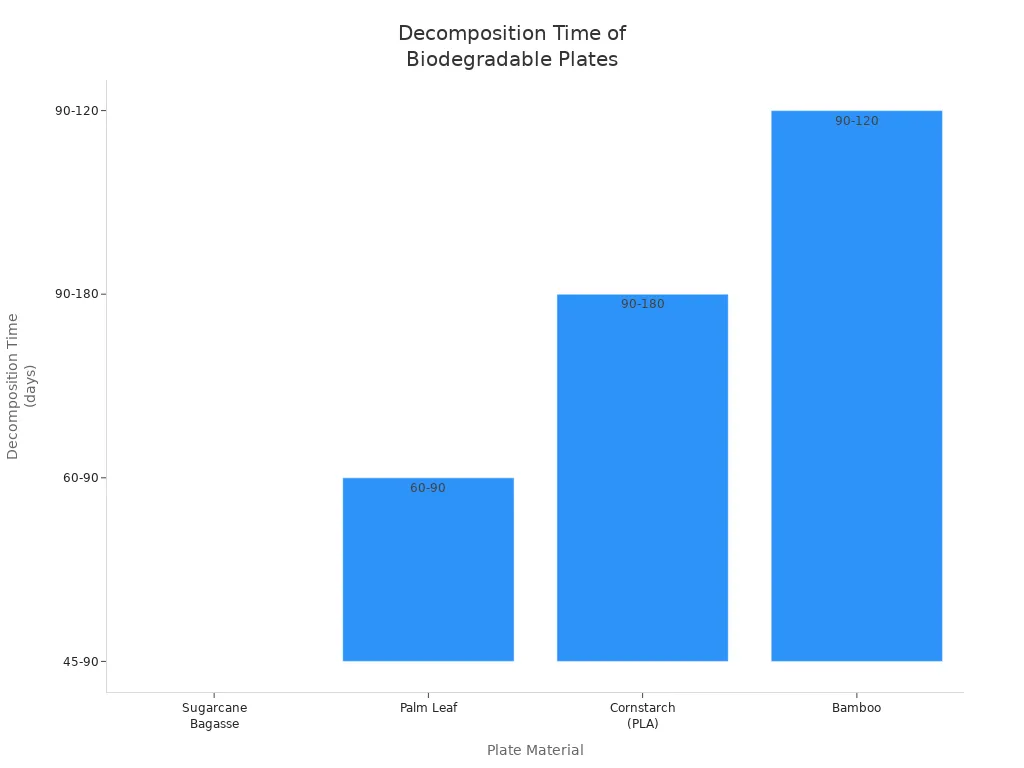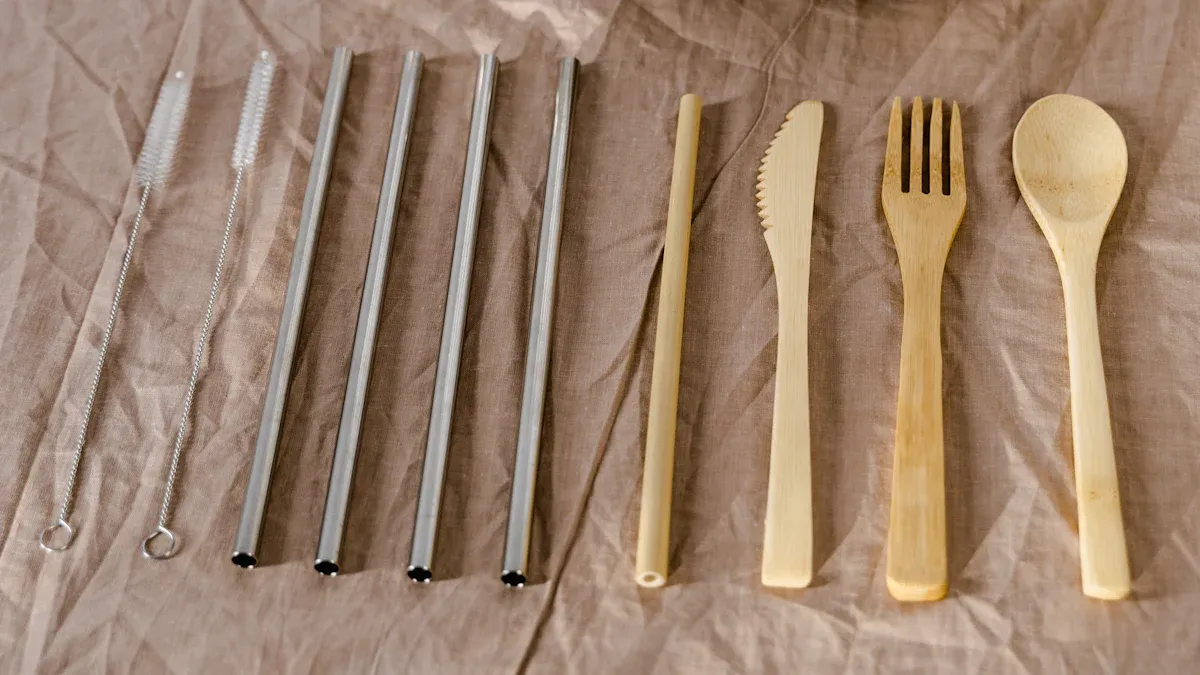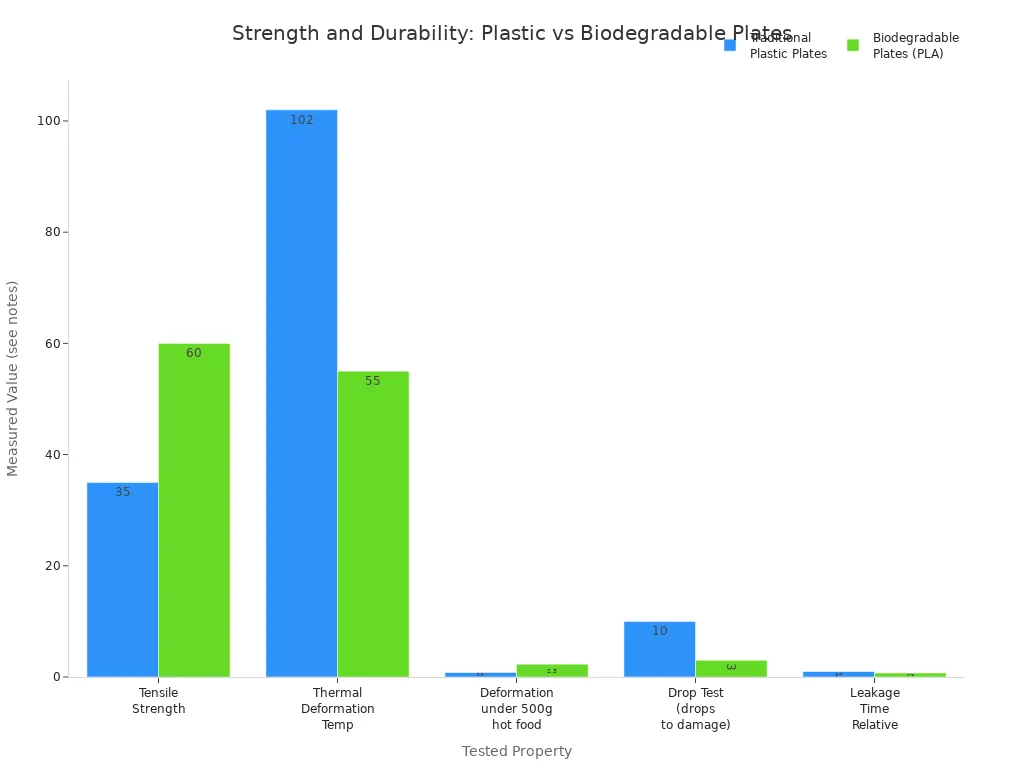Choosing biodegradable disposable plates is an easy way to help the environment. You make a difference each time you use eco-friendly disposable plates at a party or picnic. Many people ask if using eco-friendly disposable plates instead of plastic really helps. The answer is yes. Eco-friendly disposable plates break down much faster than plastic and do not hurt the environment. When you choose real eco-friendly disposable plates, you help make the planet cleaner and healthier. Your daily choices are important for a better future for the environment.
Key Takeaways
Biodegradable disposable plates break down fast. They help cut down plastic waste that hurts land and water. These plates are made from natural things like bamboo, sugarcane, and cornstarch. This makes them safe and good for your food. Using compostable plates helps soil by turning into compost. This compost is full of nutrients and does not pollute landfills. Biodegradable plates are strong for most meals. They help lower pollution and greenhouse gases. Always look for compostable certifications. Throw away plates the right way to help the environment most.
What Are Biodegradable Disposable Plates?
Materials and How They Break Down
You can help the planet by using biodegradable disposable plates. Picking these plates is a smart choice. They are made from things found in nature. Some are made from cornstarch, bagasse, bamboo fiber, or wheat straw. Each one has its own good points for eco-friendly disposable plates. Look at this table to see what makes each material special:
|
Material |
Source/Description |
Key Properties and Benefits |
|---|---|---|
|
Cornstarch |
Derived from corn |
Compostable, breaks down quickly, sturdy, lightweight |
|
Bagasse |
Fibrous residue from sugarcane juice |
Strong, heat-resistant, fully compostable, suitable for hot/cold foods |
|
Bamboo Fiber |
Fiber from rapidly growing bamboo |
Durable, biodegradable, renewable, natural look and feel |
|
Wheat Straw |
Byproduct of wheat production |
Lightweight, biodegradable, sustainable |
Plates made from these materials break down fast. You can put them in your home compost or take them to a compost facility. Most biodegradable plates disappear in just a few months. Plastic plates can stay around for hundreds of years. Using biodegradable dinner plates helps keep land and water clean. Compostable plates also give nutrients back to the soil. This is great for the environment.
Tip: Always check if your eco friendly disposable plates are certified compostable. This helps make sure they break down safely and quickly.
Biodegradable Paper Plates vs. Plastic
You might wonder how biodegradable paper plates are different from plastic. The difference is big. Biodegradable paper plates use plant fibers like bagasse and bamboo. These come from farm leftovers or fast-growing plants. They break down on their own and do not leave bad chemicals. Plastic plates are made from fossil fuels. They stay in the earth for hundreds or thousands of years. This causes pollution and tiny plastic pieces in water and soil.
Here’s a quick look at how long different plates take to break down:
|
Plate Type |
Decomposition Time Range |
|---|---|
|
Plastic Plates |
Several hundred to 1000+ years |
|
Paper Plates |
2 to 5 months |
|
Palm Leaf Plates |
About 2 months |
|
Bamboo Plates |
Approximately 6 months |
|
Cane-based Plates |
2 to 6 months |

Biodegradable dinnerware sets and plates help you make less waste. You do not add more plastic to landfills. Compostable plates break down in months, not hundreds of years. Eco-friendly disposable plates also use less energy and water to make. When you pick biodegradable dinnerware, you help the earth. Try switching to biodegradable products and see the change.
Environmental Impact of Biodegradable Plates
Image Source: pexels
Reducing Pollution and Waste
Choosing biodegradable dinnerware really helps the planet. When you use these plates, you help lower pollution and waste. Plastic and foam plates fill landfills and harm nature for a very long time. Biodegradable paper plates break down in just a few months. They do not leave behind bad chemicals or tiny plastic pieces.
-
Biodegradable plates break down in weeks or months. Plastic plates can last for hundreds of years.
-
These plates do not leave toxic leftovers. Plastic and foam can leak chemicals into dirt and water.
-
Companies make biodegradable paper plates from things like sugarcane bagasse and bamboo. This means we use fewer new resources.
-
Compostable plates can turn into rich compost if handled right.
-
Using biodegradable dinnerware could lower plastic pollution by over 70% by 2040, says a 2022 UNEP report.
-
Cities that use compostable dinnerware get better compost and less landfill trash.
Note: A real-life study showed a 40% drop in non-recyclable trash after using bagasse plates. This shows they are better than plastic and foam.
Here is a quick look at how biodegradable bagasse plates and plastic plates affect the environment:
|
Aspect |
Biodegradable Bagasse Plates |
Plastic Plates |
|---|---|---|
|
Material Source |
Sugarcane fiber, a renewable byproduct |
Petroleum-based, non-renewable |
|
Decomposition Time |
90 to 180 days under proper conditions |
Hundreds of years, creates microplastics |
|
Environmental Impact |
Turns into compost, reduces landfill waste |
Adds to landfill, increases pollution |
|
Disposal Method |
Industrial composting, supports sustainability |
Often ends up in landfill or incineration |
Biodegradable dinnerware uses less energy and makes fewer emissions when made. Plastic plates need fossil fuels and lots of energy, which adds more carbon to the air. Biodegradable paper plates, especially those made from bagasse, use natural fibers and easier steps. This makes them better for the earth.
But you must throw away compostable dinnerware the right way. If you put compostable plates in the trash, they might still break down, but they can make more carbon in landfills. Composting centers are best for these plates, but not every place has them. About 71% of composting sites take compostable food packaging, including biodegradable plates, but we do not know how many plates actually get there.
You should also know that biodegradable plates help most when you compost them. If you throw them in the ocean or wild places, they may not break down as they should. Studies show that biodegradable plates, like those made from PLA, do not always break down well in the sea. They can still hurt sea animals, just like plastic. So, always throw away biodegradable dinnerware the right way to help the environment.
Compostability and Soil Health
Compostable plates do more than just cut waste. When you compost biodegradable dinnerware, you help the soil. Compostable plates break down into natural matter in a few months. This gives nutrients back to the soil and makes it better for plants. You help farming and keep the nutrient cycle going.
-
Compostable dinnerware breaks down on its own and makes soil better.
-
This does not leave tiny plastics, unlike plastic or foam plates.
-
Compostable plates use plant-based, safe materials for soil and nature.
-
Big composting centers give the best place for these plates to break down fast and safely.
Industrial composting centers can break down biodegradable plates in about 12 weeks, depending on the material and conditions. These centers use high heat and special tools to make the process faster. Some materials, like PLA, may need more time to fully break down. The EN 13432 rule says less than 10% of the plate should be left after 12 weeks in a controlled compost.
Tip: For the best results, check if your compostable dinnerware meets composting rules and use local composting programs if you can.
Biodegradable paper plates and compostable dinnerware are a better choice than plastic and foam. They help lower pollution, make soil better, and support a greener future. When you pick biodegradable dinnerware, you help the planet and live in a more earth-friendly way.
Health and Safety of Biodegradable Plates
Free from Harmful Chemicals
If you pick biodegradable dinnerware, you help keep your family safe. Plastic plates can have chemicals that are bad for your health. These chemicals might get into your food, especially if the food is hot or oily. Biodegradable plates are made from natural things and do not have these dangers.
Here is a simple table that shows which chemicals are in plastic and biodegradable plates:
|
Chemical |
In Plastic Plates |
In Biodegradable Plates |
|---|---|---|
|
PFAS |
Yes |
No |
|
PFOA |
Yes |
No |
|
BPA |
Yes |
No |
Plastic plates use PFAS and PFOA to stop food from sticking. These chemicals can cause cancer and other sicknesses. BPA is another chemical that can mess with your hormones and growth. Biodegradable dinnerware, like bagasse or cornstarch plates, does not have these bad chemicals. You can trust that your food is safe.
Tip: Look for plates that say "PFAS-free" or "BPA-free" on the label. This helps you feel even safer.
Safe for Food Use
You want plates that are safe for all your meals. Biodegradable dinnerware is a better choice for hot and cold foods. Most biodegradable plates do not let out toxins, even with hot or sour foods. But some molded fiber plates might still have PFAS, so always check the box before buying.
Palm leaf and bamboo plates are best for hot or spicy foods. These plates come from plants and do not need extra layers. You do not have to worry about chemicals getting into your food. Biodegradable dinnerware made from these materials keeps your food healthy.
-
Pick palm leaf or bamboo plates for hot or spicy meals.
-
Do not use plates with shiny layers, as they might hide chemicals.
-
Always look for labels that show your plates are safe for food.
When you use biodegradable dinnerware, you make a good choice for your health and the earth. You keep bad chemicals away from your food and body. Your choice helps make the world cleaner and safer for everyone.
Durability, Cost, and Everyday Use
Strength and Performance
You want plates that do not break at your party. Biodegradable plates are strong enough for most foods. They work well for one-time meals, even with hot or greasy food. Sugarcane plates can go in the microwave and freezer. Palm leaf and bamboo plates are good for hot foods and look nice. Cornstarch plates stay strong with hot and oily foods, but need special composting.
Plastic plates feel harder and do not bend or break easily. They do not soak up liquids, so you do not get soggy plates. Foam plates also stop leaks, but they hurt the earth and last a long time in landfills. Biodegradable plates might get soft if you leave soup or sauce on them for a while. New designs make these plates stronger every year.
Here is a quick chart to compare plates:
|
Property / Test |
Traditional Plastic Plates (PP) |
Biodegradable Plates (PLA, Bamboo Fiber) |
Notes / Advances |
|---|---|---|---|
|
Tensile Strength |
30-40 MPa |
50-70 MPa (PLA) |
PLA is stronger but more brittle |
|
Heat Resistance |
102°C |
55°C (PLA) |
Plastic resists heat better |
|
Drop Test |
Intact after 10 drops |
Bamboo fiber plates damaged by 3rd drop |
Plastic is tougher |
|
Liquid Leakage |
No early leakage |
PLA leaked 27% earlier |
Plastic wins here |
 Tip: For most parties or family meals, biodegradable plates are strong enough. You help the earth and still enjoy your food.
Tip: For most parties or family meals, biodegradable plates are strong enough. You help the earth and still enjoy your food.
Cost Comparison
You may see that biodegradable plates cost more than plastic or foam. Many things change the price:
-
Making biodegradable plates costs more and needs special machines.
-
Rules and bans on plastic make more people buy biodegradable plates.
-
New ways to make biodegradable plates can change the price and quality.
-
More people want eco-friendly plates, so companies change prices.
-
Competition and new styles also change what you pay.
-
Big events and restaurants buying lots of plates can make prices go up or down.
-
Local rules and keeping plates good quality can change costs.
-
What people think about how well biodegradable plates work can change prices.
Foam and plastic plates are cheap because they use old ways that pollute. Biodegradable plates cost more now, but prices go down as more people buy them. You pay a little more for a cleaner world and show you care about the future.
Choosing biodegradable plates means you spend a bit more, but you help the planet and your health. Your choice matters.
Choosing Eco-Friendly Disposable Plates
Tips for Selection
You want to help the earth and stay healthy. When you shop for eco-friendly disposable plates, look for trusted labels. Find certifications like ASTM and BPI on the box. These show the plates are compostable and biodegradable. Some states, like California and Connecticut, need these labels by law. Local rules may also ask for special labels to make sure plates break down where you live.
-
Pick compostable plates made from bamboo, bagasse, or palm leaf. These are better for the planet.
-
Stay away from plates with plastic coatings or PFAS. These can hurt nature and your health.
-
Buy paper plates that say "compostable" and have BPI or ASTM labels.
-
Check if your town has a composting center before you buy.
Tip: Many compostable plates, like those made from PLA, only break down in big composting centers. Always read the label and know where you can compost them.
Here is a table to help you compare good choices:
|
Plate Type |
Best For |
Certifications to Look For |
|---|---|---|
|
Bamboo |
Hot/cold foods, sturdy |
BPI, ASTM |
|
Palm Leaf |
Home compost, natural |
BPI, ASTM |
|
Bagasse (Sugarcane) |
Versatile, microwave |
BPI, ASTM |
|
Paper |
Affordable, recyclable |
BPI, FSC |
Proper Disposal
You help the planet when you throw away eco-friendly plates the right way. Never put compostable plates in the recycling bin. This can mess up recycling and make more trash. Plates made from bagasse, bamboo, or palm leaf can go in your home compost. Cut them up and mix with green waste. Compostable bioplastics, like PLA, need high heat from big composting centers.
-
Do not put compostable plates in recycling bins.
-
Plates with food on them can still go in the compost pile.
-
If you cannot compost, throw compostable plates in the trash, not recycling.
-
Always follow your local rules for compostable and biodegradable plates.
Note: Many people mix up biodegradable and compostable plates. Compostable plates need special places to break down. Biodegradable plates may not break down well at home and can leave waste if not handled right.
When you buy eco-friendly paper plates and use compostable dinnerware, you help the earth. Your choices make companies offer more green products. You help make the world cleaner and greener every time you pick eco-friendly plates.
When you use biodegradable disposable plates, you help the earth and your health. You stop plastic waste from growing. You also make your carbon footprint smaller. This helps keep your town clean.
-
Using bioplastics instead of plastic can stop up to 4.3 gigatons of CO₂ by 2050.
-
Composting plates keeps landfills from getting too full and helps soil stay healthy.
|
Benefit |
Impact |
|---|---|
|
Less Plastic Waste |
Land and water stay cleaner |
|
Healthier Soil |
Plants can grow better |
|
Lower Greenhouse Gas Emissions |
Climate problems are less |
Your choice is important. Shop biodegradable plates at ECOLipak now and show others how to help! 🌱





